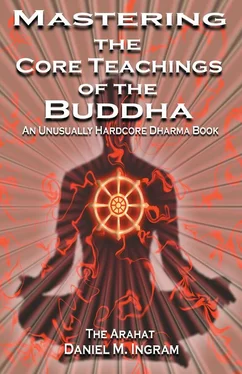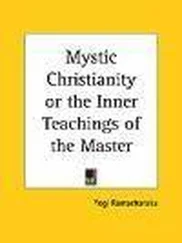Daniel Ingram - Mastering the Core Teachings of Buddha - An Unusually Hardcore Dharma Book
Здесь есть возможность читать онлайн «Daniel Ingram - Mastering the Core Teachings of Buddha - An Unusually Hardcore Dharma Book» весь текст электронной книги совершенно бесплатно (целиком полную версию без сокращений). В некоторых случаях можно слушать аудио, скачать через торрент в формате fb2 и присутствует краткое содержание. Год выпуска: 2009, ISBN: 2009, Издательство: Aeon Books, Жанр: Старинная литература, на русском языке. Описание произведения, (предисловие) а так же отзывы посетителей доступны на портале библиотеки ЛибКат.
- Название:Mastering the Core Teachings of Buddha - An Unusually Hardcore Dharma Book
- Автор:
- Издательство:Aeon Books
- Жанр:
- Год:2009
- ISBN:9781904658405
- Рейтинг книги:5 / 5. Голосов: 1
-
Избранное:Добавить в избранное
- Отзывы:
-
Ваша оценка:
- 100
- 1
- 2
- 3
- 4
- 5
Mastering the Core Teachings of Buddha - An Unusually Hardcore Dharma Book: краткое содержание, описание и аннотация
Предлагаем к чтению аннотацию, описание, краткое содержание или предисловие (зависит от того, что написал сам автор книги «Mastering the Core Teachings of Buddha - An Unusually Hardcore Dharma Book»). Если вы не нашли необходимую информацию о книге — напишите в комментариях, мы постараемся отыскать её.
Mastering the Core Teachings of Buddha - An Unusually Hardcore Dharma Book — читать онлайн бесплатно полную книгу (весь текст) целиком
Ниже представлен текст книги, разбитый по страницам. Система сохранения места последней прочитанной страницы, позволяет с удобством читать онлайн бесплатно книгу «Mastering the Core Teachings of Buddha - An Unusually Hardcore Dharma Book», без необходимости каждый раз заново искать на чём Вы остановились. Поставьте закладку, и сможете в любой момент перейти на страницу, на которой закончили чтение.
Интервал:
Закладка:
One may experience Dark Night-related phenomena in this phase. As the shift to the fourth jhana comes, the mantra may become part of a very wide, more quite background, as attention becomes inclusive.
Other fourth jhana-like or high equanimity-like phenomena may occur around here.
Thus, the vipassana jhana model can really help people line up experiences across objects, traditions, and practitioners, as they get to the common ground of spiritual terrain in a more fundamental way than the ñanas may, as those with strong concentration abilities may dodge a lot of the emotional side effects that are emphasized by that map, and 224
The Vipassana Jhanas
those using different objects may have such seemingly different pathways. However, now that you know the vipassana jhanas, if you practice well or ask good questions of those you speak with, you should have a much easier time of lining things up and making sense of things.
Another thing that can help is noticing that each jhana has its smaller aspects that can be classified in a manner different from the ñanas, and here I refer to what Bill labeled the sub-jhanas. As I mentioned on the section on the samatha jhanas, each jhana, vipassana or otherwise, has its sub-phases. Initially, the jhana is new, fresh, clear, but perhaps a bit unsteady as the mind gets used to it (first sub-jhana), then it really comes into its own (second sub-jhana), then the flaws and limits of the jhana are perceived (third sub-jhana), then there is some sort of balanced synthesis of these that at once allows the flaw and begins to incorporate the pull towards that which comes next (fourth sub-jhana).
In this way, it is possible to see models within models within models, and if you practice long and clearly enough with the models in mind you will run into this aspect of things. The warnings about the problems with the models go ten times or more for the sub-jhana models and deeper fractal theories of meditation terrain. They are a largely endless subject whose usefulness is debatable and whose perils are well known.
Consider yourself duly warned!
FRACTALS
Unfortunately, I somehow am not able to keep myself from
presenting just a few of the basics of fractal theory here, particularly as it relates to Bill’s model. There is also something exceedingly universal about the pattern that I am about to present, and resonances of it are found back as far as there is recorded human history, religion and art.
If you consider the first 360 degrees of a sine wave (like a rounded capital italic “N” that has been tilted just a bit to the right), you will notice that is starts at zero, goes up in a hill-like way, peaks, descends below where it started in a valley-like way, bottoms out, and then returns to the same level at which it began but yet farther along.
Were one walking on this curve, one would have to make effort to climb up the hill. One would then have a spectacular view and a great sense of accomplishment. One might then try to keep walking up to get more of this, but end up sliding down the other side of the hill, farther 225
The Vipassana Jhanas
down in fact than where one began. And yet, this is still progress, and could even be somewhat thrilling and even effortless with the right attitude. Just when one gets to the very bottom, trapped in the darkest part of the pit, by finally coming to rest at the absolute bottom the upward motion begins to happen naturally, and one returns to where one was, ground zero, and yet farther on at the same time. A cycle is complete and yet begins again endlessly.
This easily correlates with the first four vipassana jhanas, as well as many other obvious cycles such as those of the sun and seasons, etc. For those trying to correlate the maps of the progress of insight with those of Tantra’s Five Buddha Families or those of any number of pagan and nature-based traditions, this should prove most helpful. The first vipassana jhana is climbing up the hill, eager beginnings, hard work, dawn, Spring, East, etc. The second vipassana jhana is the giddy high of accomplishment at the top of the hill, high noon, Summer, South, etc.
The third vipassana jhana is the exhilarating and yet scary fall far down the other side into a cool and shadowy valley, dusk and nightfall, Autumn, West, etc. The fourth vipassana jhana is coming to rest regardless of where one is and returning to one’s origin naturally, the cool of the dead of night and early morning, Winter and the promise of Springtime, the coming of a new year at the end of the old, a time of rest, completion and renewal, North. The correlations with the stages of insight are thus obvious. One may also correlate this with some of the models of awakening, particularly the Four Path Model and the Simple Model of awakening, both of which will be explained later.
Interestingly, one may begin to see a full cycle of each of these stages in each of the four vipassana jhanas as well, with each peak and valley adding or subtracting from the position of the greater wave it is an aspect of. For all you incurable model geeks, try plotting y=sin(x)+0.25*sin(4x) from x=0 to 2π on a graphing program. You have my sympathy. The x-axis is the jhanas and sub-jhanas, from 1.1 to 4.4, or 1.1.1 to 4.4.4 if you want to go into sub-sub-jhanas. Unfortunately, what goes on the y-axis would be the subject of a book longer than this one and would read like the most difficult works of Aleister Crowley. In short, the possible complexity of this model is endless and it is no substitute for practice.
226
The Vipassana Jhanas
Try not to become an arrogant twit like I did when I began to figure all this stuff out. Esoteric map theory won’t win you any friends.
I have spent way too much time thinking about the fractals and modeling in my own practice. In my insecure moments, I have
considered showing off and writing a book that detailed the hundreds of little parallels and patterns that I have noticed over the years, how this tiny little stage of some vipassana sub-jhana mirrored or was in inversion of another aspect of some other little stage of some other sub-sub-jhana, but I couldn’t come up with any practical use for it at all. If you do the technique, you will see all of this and more. If not, reading about it won’t help you. It’s just another content trap, but a seductive one for us pseudo-intellectuals. On the other hand, Khabbala seems to have made related permutations into meditation itself, and those who are particularly inclined to this sort of analysis might want to try taking it as a vehicle for going beyond it. Also, guess where the complex geometric Tibetan Mandalas that are supposed to be pictures of the Mind or the Universe come from? Bingo!
U PANDITA’S MODEL
U Pandita, one of the greatest modern masters of meditation in the Burmese Theravada tradition (see his work In This Very Life) doesn't quite agree with Bill and I about how the ñanas and jhana line up, and so I thought that in the interest of fairness I would present his model .
In his model, as in Bill's model, the first three stages of Mind and Body, Cause and Effect, and The Three Characteristics all fall within the first vipassana jhana. However, he divides the Arising and Passing Away into two jhanas, with the immature phase (when the meditator is still in the grip of the Ten Corruptions of Insight) corresponding to the second jhana and the mature phase (when the meditator sees the true nature of the Ten Corruptions of Insight and crosses the A&P Event) as the third jhana. Everything from Dissolution to Equanimity then falls into the fourth jhana in his model. This does accommodate the vague formless experiences that can happen in Dissolution, as the formless realms come out of the fourth jhana.
The problem with this map is similar to the problem with the other maps, namely that some of the stages of insight tend to suck and the samatha or pure concentration jhanas are always a good time or 227
Читать дальшеИнтервал:
Закладка:
Похожие книги на «Mastering the Core Teachings of Buddha - An Unusually Hardcore Dharma Book»
Представляем Вашему вниманию похожие книги на «Mastering the Core Teachings of Buddha - An Unusually Hardcore Dharma Book» списком для выбора. Мы отобрали схожую по названию и смыслу литературу в надежде предоставить читателям больше вариантов отыскать новые, интересные, ещё непрочитанные произведения.
Обсуждение, отзывы о книге «Mastering the Core Teachings of Buddha - An Unusually Hardcore Dharma Book» и просто собственные мнения читателей. Оставьте ваши комментарии, напишите, что Вы думаете о произведении, его смысле или главных героях. Укажите что конкретно понравилось, а что нет, и почему Вы так считаете.












